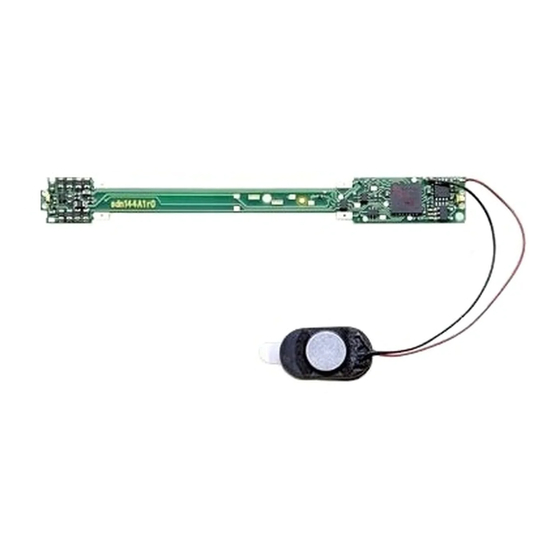Digitrax SoundFX SDN144A1 Manuel - Page 4
Parcourez en ligne ou téléchargez le pdf Manuel pour {nom_de_la_catégorie} Digitrax SoundFX SDN144A1. Digitrax SoundFX SDN144A1 12 pages. Drop in mobile decoder for atlas n scale sd60/40 and similar locomotives

7. Connect to active DCC track power from a compatible DCC system and
select the factory default address 03 to enable sounds for testing
8. Be sure F8 (mute) is OFF to allow sound output, and after track power is
applied and the engine "starts", press F1(bell) or F2 (whistle/horn) ON to hear
these associated sounds. When removing the shell, note that the speaker is a
snug fit and do not pull on the speaker wires to remove the speaker from the
shell.
9. Customize sounds by programming Sound CV's to adjust the desired con-
figurations, as shown in the following tables of Sound FX CVs. CV60=0
sound scheme is a SD60 and CV60=1 is an SD40. Other locomotive sound
projects may be downloaded from the Digitrax web site and conveniently pro-
grammed using a PR3 programmer. This "A1" form-factor PCB may be used
in a number of other N scale locomotives by applying a little modeling ingenu-
ity.
Speaker Mounting and baffle or enclosures.
The sound performance of any attached speaker(s) is greatly affected by the
mounting system and required baffle or rear enclosure space. Depending on
the locomotive model and construction and speaker chosen it may be necessary
to modify the frame or parts of the internal shell to make room for one or more
speakers and enclosure.
For the Atlas N scale SD60 installation shown here the whole body acts as a
sound baffle once the shell is in position. To optionally increase the sound vol-
ume it is possible to drill out the three rear fan details and replace these with
painted BLMA brass fan parts that permit the improved venting of sound.
Obviously the space inside this N-scale locomotive is limited since the frame is
configured for maximum weight and pulling effort, and the installation shown
here is just one variation of the possible locations for a speaker.
The baffle is used to isolate the speaker diaphragm front sound waves from the
"out of phase" rear sound waves. This minimizes sound cancellation, particu-
larly at lower frequencies. For most efficient sound generation, the cubic space
of the baffle should be as large as practically possible, and the baffle walls
should be acoustically rigid so not to allow acoustic interference.
For example, you can wire in the SDN144A1 in a modern HO-scale locomo-
tive with a high-efficiency can style motor as long as the stall current is less
than 1 amp at the track voltage in use. In this case it is possible to change to a
larger speaker(s) that has a "high bass" or similar enhancement. For best oper-
ation it is useful to connect the optional 100uF storage capacitor or larger value
to help overcome pickup dropouts due to dirty track etc.
©2011 Digitrax, Inc.
Complete Train Control
Run Your Trains, Not Your Track!
www.digitrax.com
4
